“Who Mourns for Morn?”
Written by Mark Gehred-O’Connell
Directed by Victor Lobl
Season 6, Episode 12
Production episode 40510-536
Original air date: February 4, 1998
Stardate: unknown
Station log: Morn has gone away on business for two weeks, and so Quark has replaced him with a hologram. It’s better for business if customers see Morn in his usual place at the bar, and the last time he was away from the station for an extended time, profits were down 5%. The hologram isn’t interactive, as that would be more expensive—besides, Quark prefers this version, as the real Morn just never shuts up.
Sisko and Dax enter the bar, taken aback by the sight of Morn, and relieved when told it’s not really him, as they just got a report that his transport was caught in an ion storm, and Morn was killed.
The funeral is held at Quark’s. Per Lurian tradition, everyone brings a gift of food and drink to sustain the dead in the afterlife. Quark delivers a touching eulogy, talking about the first day he came in ten years earlier. Back then he still had hair. Quark ends by encouraging people to respect Morn’s memory by keeping the bar warm and his stool occupied forevermore.
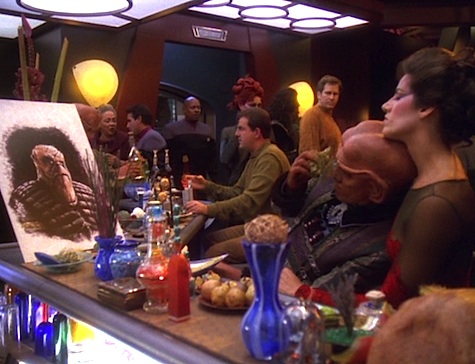
Sisko then informs Quark that Morn’s will declared that he left everything to Quark. However, “everything” consists of four crates of Livanian beets, a matador painting, and a giant mudbath. However, there’s a woman in the mud named Larell, who claims to Morn’s ex-wife. She also claims that Morn won a thousand bricks of gold-pressed latinum in the Lissepian lottery. “Now that he’s gone,” Larell says, “it’s all ours.”
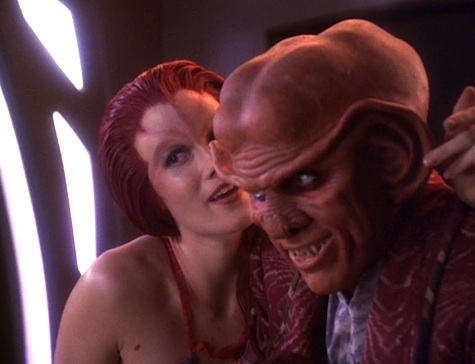
To Larell’s disappointment, Quark has no idea where the bricks are. (She insists on getting 10% of the latinum, otherwise she’ll contest the will and tie Quark up in court.) Quark searches everywhere, even having Rom use the station’s internal sensors, but he can’t find it.
When Quark returns to his quarters, two brothers, Krit and Nahsk, are waiting for him, claiming to be former business associates of Morn’s, and to whom Morn owed one thousand bricks of latinum. (Quark is totally not surprised to learn that that was the amount.) Quark bluffs, saying that he knows where the money is, but there are more creditors than there are assets, so he can only give them a percentage. They ask for 80%, Quark manages to negotiate them down to 50% (after Nahsk hits him with the matador painting).
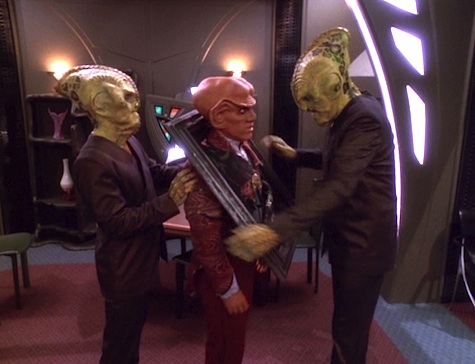
In the painting, Quark finds a claim chit for a storage locker in the assay office. The locker contains one brick of latinum, plus a note on the bottom of the brick, saying that the rest of the bricks are in the Bank of Bolias and gives the account number. Quark pockets the brick and then bumps into Larell, who lifts the brick from his pocket. Quark’s not worried, though, as the bank will only give the money to him, as Morn’s rightful heir, and he’s memorized the account number.
Then he’s waylaid by Krit and Nahsk, and—under the guise of apologizing to him for whacking him on the head with the painting—threaten him once again. He arrives at his quarters, sets up to make the withdrawal, only to be held at gunpoint by a human named Hain, who flashes a Lurian security badge. He says that Morn was a prince, and the thousand bricks was a gift from the Lurian royal family. Hain is there to arrest Quark for possession of stolen property, to wit, the thousand bricks. Now that Morn is dead, the money belongs to the royal family.
However, Hain gets nervous when Quark mentions that Morn’s ex-wife Larell is on the station. (He asks Hain not to tell her about the royal family, as he’ll need some oo-mox later.) Hain now claims that she’s been after that latinum for years. He offers Quark a substantial reward for helping to imprison Larell. Quark also mentions the two brothers, and while Hain claims not to know who the brothers are, he obviously recognizes them. For his part, Quark just cares about a) getting a reward for helping imprison Larell and b) not being arrested for trying to steal the royal family’s money.
Hain tells Quark to proceed with the retrieval of the latinum, and to have the bank send it to the station. He’ll take care of the rest.
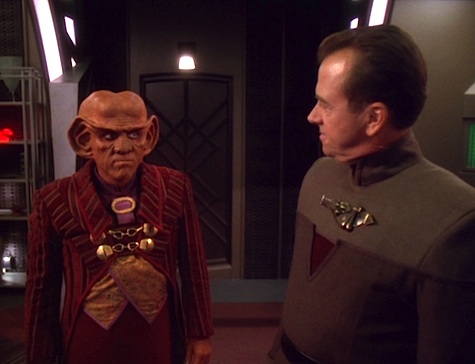
O’Brien fixes a part at the bar, keeping Morn’s seat warm as Quark requested. He explains that to Bashir, who says, “Good man.” When O’Brien goes off to test it, Bashir figures he should take over, so he sits in the seat. O’Brien nods and says, “Good man.”
Quark arrives in his quarters to find Larell there, to his total lack of surprise. She says she’s being followed by two men. “Brothers?” Quark asks, and her face looks like she’s about to answer in the affirmative, but then she quickly recovers and asks how she should know if they’re brothers.
Sure enough, Krit and Nahsk arrive. When Quark refuses to answer the doorchime, they pick the lock. Quark has dimmed the lights and is hiding with Larell when they enter, Quark muttering that he should invest in a better lock. Quark comes out of hiding and assures the brothers that the latinum will be there tomorrow. The doorchime then rings again. The brothers tell him not to answer it, at which point the lock is again picked. Nahsk tells Quark he should invest in a better lock, and then he and Krit go hide in the bedroom.
It’s Hain this time. Quark covers his non-answering of the door by saying he dozed off. “It’s been one of those days.”
It quickly becomes clear that all of Quark’s harassers know each other and that at least two of them are full of it. Larell isn’t Morn’s ex-wife, Hain isn’t a security agent for Luria, and the two of them, Krit and Nahsk, and Morn all worked together in the past: they committed the famous Lissepian Mother’s Day Heist nine years earlier. Morn made off with the latinum, but it wasn’t an issue until the statute of limitations on the theft ran out. That happened two weeks ago, so the others all came after Morn—and, once he died, his heir. Now, though, the latinum’s en route anyhow, so they can just split it four ways—once they dispose of Quark.
Quark reminds them that they need Quark to take delivery of the latinum. He’s the rightful heir, and if he’s dead, they get nothing. Quark proposes that he gets Morn’s share, which seems only fair, and the others reluctantly agree. But they stick by Quark, giving them a chance to see where Morn spent all his time. None of them are willing to admit to killing Morn, at which point Hain laughs and, surprised, says, “It really was an accident!”
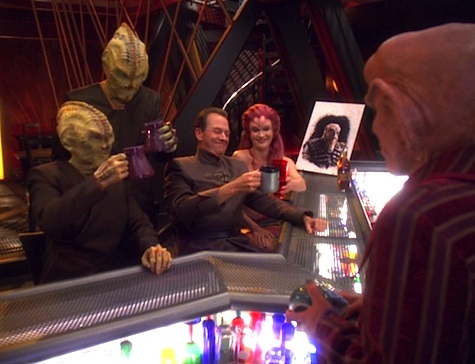
Odo stops by, and Quark tells him the bar is closed. The others are friends of Morn’s, and they’re commiserating. The bar will be closed until 1600 hours tomorrow (which is when the latinum arrives). At Odo’s look, Quark just says, “We have a lot to commiserate about.”
The next day, the five of them go to the cargo bay, Quark puts his thumbprint on the padd, he opens the container to find 999 bricks of gold-pressed latinum. The four thieves all then pull their weapons on each other. Nahsk winds up pulling on Krit, to the latter’s shock—“We’re family!”—and then all four start shooting. While the thieves go all last-scene-of-Reservoir-Dogs on each other, Quark dives into the container to wait out the shootout. Eventually, Odo shows up, and arrests the foursome. This leaves Quark with all the money—
—except it turns out that it isn’t gold-pressed latinum. It’s just gold—the latinum (which is liquid, and which is suspended in gold as a delivery agent only) has been extracted. Quark now has 999 bricks of “worthless gold.” Odo just grins and says, “And it’s all yours.”
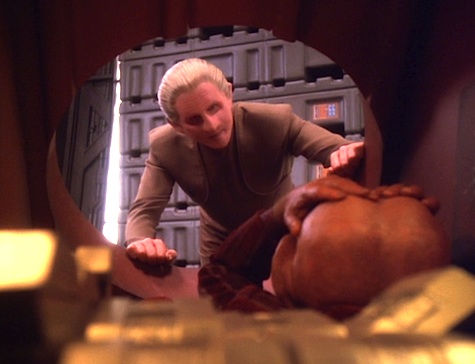
Later, Odo shows up at Quark’s with a surprise guest: Morn. He faked his own death, leaving everything to Quark so he would send for the money at the bank, knowing that Quark would keep the other four off-balance long enough for them to eventually turn on each other.
Quark says he just has one question: “What happened to the latinum?” In response, Morn coughs up liquid. He extracted the latinum from the gold and stored it in his second stomach all these years. Quark is impressed—“No wonder your hair fell out”—and Morn gives him about 100 bricks’ worth as payment for what he went through.
Can’t we just reverse the polarity? We finally find out what gold-pressed latinum is: a rare and valuable liquid suspended in gold. As Dax explains, the gold is there to keep people from having to make change with an eye-dropper.
The slug in your belly: Even though she’s an old married lady, Dax still plays tongo with Quark.
There is no honor in being pummeled: Worf apparently has weekly sparring sessions with Morn. Who knew?
Preservation of mass and energy is for wimps: Odo takes great joy in snarking off Quark throughout the episode, from making fun of his Morn hologram to making fun of his status as Morn’s heir meaning he hasn’t actually inherited hardly anything except for some stinky beets to his kicking Quark when he’s down when he realizes that the latinum’s been extracted from the gold.
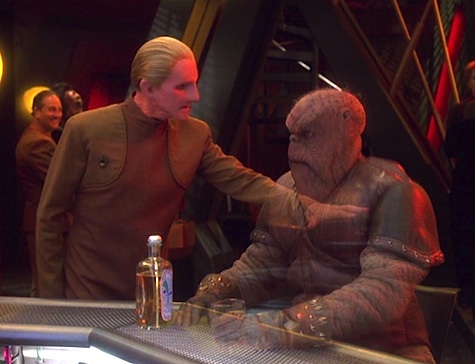
Rules of Acquisition: Quark gives a eulogy that was probably legitimately heartfelt, as his love for Morn was as much related to the consistent presence he left as well as his considerable bar tab. Morn also knows him well enough to know that he’ll take care of business after he faked his death.
No sex, please, we’re Starfleet: Larell uses her naked body and oo-mox to get Quark to cooperate with her, though Quark doesn’t fall for it nearly as much as she thinks he does—he’s mostly in it for the oo-mox. Also Dax makes the supreme tactical error of telling her new husband that she used to have a crush on Morn (something she also once confided to Kira).
Keep your ears open: “…”
Morn.
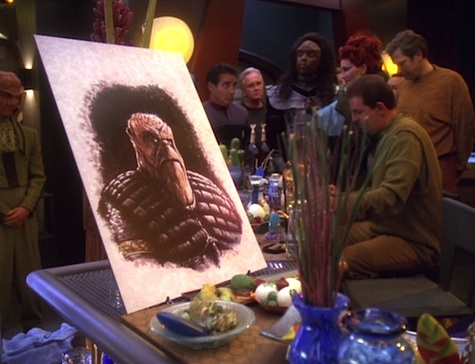
Welcome aboard: While I’ve never really mentioned him in this section of any other episode, Mark Allen Shepherd has been playing Morn pretty much since the beginning of the show (and he also appeared in “Birthright” on TNG and “Caretaker” on Voyager). In this episode he does double duty, as Morn and also as the Bajoran to whom Quark instructs to keep Morn’s seat warm during the funeral. Hilariously, Shepherd is not generally credited as Morn, since he’s an extra with no dialogue (his not having dialogue being part of the joke), and that extends to the episode named after the character. You’d think for this one at least, they’d give the poor bastard a credit…
The guests who actually are credited include the great Gregory Itzin—last seen as Tandro in “Dax”—as Hain, Brad Greenquist—last seen on Voyager’s “Warlord” as Demmas—as Krit, Bridget Ann White as Larell, and Cyril O’Reilly as Nahsk. Itzin will show up on Voyager’s “Critical Care,” and twice on Enterprise, as a Vulcan in “Shadows of P’Jem” and an evil admiral in “In a Mirror Darkly, Part II.” Greenquist will appear as two other types of aliens on Enterprise in “Dawn” and “Affliction.”
Trivial matters: The producers had been struggling for years to figure out a way to do a Morn episode that would retain the gag that the character never speaks on camera (but can’t shut up off camera). It was Mark Gehred-O’Connell who came up with the scenario of a Morn-focused episode in which the character is mostly absent. However, Rene Echevarria did a page-one rewrite of Gehred-O’Connell’s script, changing it from a search for Morn, who has disappeared, to the aftermath of his apparent death.
Armin Shimerman has said many times in interviews and in person that he always made an effort to be friendly to the guest stars and the extras. This included Shepherd. Shimerman’s solicitousness was part of why Morn became something like a breakout character (or at least an entertaining running gag), which led to this episode happening.
The matador painting that Nahsk smashed over Quark’s head was purchased by Morn at the auction held in “In the Cards.”
Walk with the Prophets: “There’s nothing here but worthless gold!” This is a cute little caper episode, with the biggest problem being that it requires Quark to be really stupid, mostly in his dealings with Hain. He’s smart enough when dealing with Krit and Nahsk to ask for documentation—which they don’t have, of course, but at least Quark asks—and he plays along with Larell for the oo-mox, but when Hain shows up, he misses the obvious clues that he’s full of it. It wouldn’t be so bad except for the fact that Quark knew what he was in for with both Larell and the brothers, so why did he just go along with Hain? It’s not like he automatically trusts authority as his every interaction with Odo proves.
Hain’s con almost works because after everything else we’ve gotten in the episode about Morn, him being a prince is just the latest absurdity in a series of them.
But that’s ultimately the problem. Morn is a gag character. The episode is an extended version of that gag, but once you get past the entertainment value of everyone mourning someone whom they know all about but about whom we know nothing, there really isn’t a lot of there there.
Having said that, the episode has its moments. All the actors do superbly, from the always charmingly smarmy Gregory Itzin, to the hilarious double act of not-so-charmingly-smarmy Brad Greenquist and the dumb-but-disloyal Cyril O’Reilly, to the sultry Bridget Ann White (who’s actually most effective when slinking around in the mud bath; once she has to stand up straight, she loses a lot of her appeal—her body language while rolling in the mud is most of what made that scene work).
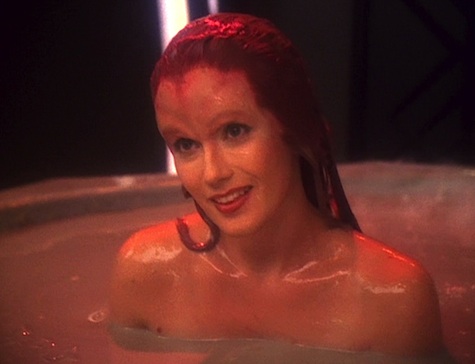
But ultimately, I would rather have seen Quark as, well, smarter than this. Morn used Quark for this scheme because he figured that the Ferengi would be able to bring about the end result we saw, but that result pretty much only happened by accident. I think it might’ve been more fun if Quark actually served as a mastermind who saw through all the thieves’ deceptions (it’s not like they were particularly good deceptions) and set them all up for the fall.
Still, this is, ultimately, a gag episode about a gag character, and the gag loses steam at the end when we get the full story, but Quark has to say all of it in order to keep the gag going. It doesn’t work at that point, and the ending falls flat because we can see the strings.
Warp factor rating: 4
Keith R.A. DeCandido is at RocCon in Rochester, New York this weekend, alongside Trek actors Brent Spiner, Vic Mignogna, and Tim McCormack; fellow authors Lois Gresh, Michael Joy, Megan J. Parker, and Nathan Squiers; artists Rick Stromoski, Alex Saviuk, Ray McCarthy, Matt Keenan, and Salvatore Otero; actors Alaina Huffman, Billy West, and Bonnie Piese; autism advocate Alec Frazier; wrestler Brimstone; musicians The Adarna; cosplayers The 501st Legion, Ace Fett Cosplay, and Alanaleilani R & Duplicitous Dichotomy; filmmaker Nate Sorrentino; the Geek Girl Project; and the Starship Horizons Bridge Simulator. Keith will have a table in the dealer’s room, where he’ll be selling and signing books (including Star Trek: The Klingon Art of War and Sleepy Hollow: Children of the Revolution), and also doing a Q&A tonight at 7:30pm and a panel on Trek (with Gresh and McCormack) Saturday at 11:30am.










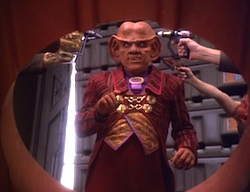
I like this a little better than KRAD did. I’d probably give it about a 6. Sure, it would be better if Quark saw through all of the conspirators but I suppose Quark was thrown by the royalty bit. As you said, it’s so absurd that it’s plausible.
I really don’t have much to say about the episode itself, as I mostly agree with this assessment, but I did get a laugh at Worf’s indignation that Morn just wasn’t interested.
Although there is probably some obligatory thing to be said here about the gag (which applies even more to Larell) if an ‘ugly’ (well, who knows, he could be a totally studly Lurian) male with a totally hot (humanoid) female. I know that there could be a case made for seing beyond looks, but I feel like this trope is often just a way to assume that the ‘default’ is that of course all men are attracted to those types of women.
Much like I didn’t see “A Fistful of Datas” until about a year ago, this is the only episode of DS9 that I’ve never seen. Probably should fix that someday. Stange coincidence that they’re both highly gimmicky episodes..
I’m fond of this episode because I love the conceit of taking the Morn running gag and making him the actual title character of an episode… yet still never give him a line. Having him be absent for most of it was a brilliant solution. Although it falls apart when he has that big long scene at the end and still never speaks despite having many opportunities, which belies the conceit of his off-camera garrulousness.
Honestly, all the business with the conspirators and their rivalries doesn’t work for me all that well; but I was just enjoying the fact that this episode exists too much to be bothered by that. Also points for the deft and Trek-referential wordplay in the title.
And ever since this episode, it’s disappointed me that no later Trek production, comic, or novel ever picked up on the gag here and portrayed a different Lurian character with a lush mane of hair.
Who else here has thought at least once about what it would be like to sit next to Morn at a bar?
I just noticed a small plot hole. Quark shouldn’t have been disappointed with having plain gold. It’s been established the Ferengi treasure their gold, given their outraged reaction to Riker’s combadge on The Last Outpost.
Perhaps Last Outpost predated the Ferengi’s aquisition of replicator technology? Once they gained it, then they’d have to move their economy onto Latinum.
Or maybe this is giving The Last Outpost the Threshold treatment and expunging it from continuity, in which case I say Good Riddances to it.
@7: What does replicator technology have to do with it? Gold is a chemical element, and as far as I’m aware replicators don’t do nuclear fusion/fission to create those, but use existing supplies.
@7: Any long-running canon will tweak its details over time; ignoring one line or reference in an episode doesn’t necessarily mean rejecting the whole thing. For instance, the retcon in “Datalore” that Data preferred not to use contractions — and the subsequent misinterpretation in episodes like “The Offspring” that he was incapable of using contractions — doesn’t mean that the many first-season episodes in which he did use contractions were removed from continuity; it just means that small detail from those episodes was disregarded.
Back when Star Trek: The Motion Picture came out, Gene Roddenberry advised fans to accept that the Klingons had always had ridged foreheads, but the original series just hadn’t portrayed them accurately. In his novelization of the film, he suggested that TOS had been a dramatization of Kirk’s “real” adventures and had been “inaccurately larger-than-life” in some respects. It can be very helpful for dealing with Trek’s many inconsistencies, large and small, if you suppose that we’re seeing approximate representations of the “reality” of the universe rather than witnessing it directly.
@6: Maybe the Ferengi in The Last Outpost were from a different faction of Ferengi society than Quark. If so their faction might revere gold for cultural or religious reasons that Quark’s faction doesn’t share. (Certainly the Ferengi having multiple cultural groups would help explain why the Ferengi we see on DS9 are generally much more pacifistic than the rather militaristic Ferengi we usually saw on TNG.)
@8: First, I’m pretty sure that replicators work on the same principle as the transporters, and so are creating matter directly from energy and are not limited by element stocks. Second, Latinum derives most if not all of it’s value as a currency from the fact that it cannot be replicated. I’m pretty sure it has no established industrial uses, just the fact that it is counterfeit/inflation-proof in a universe where no other physical currency can be (and it really looks like decryption technology has outrun encryption same in the Star Trek universe, so digital currencies are likely also a no-go.)
Quark seemed pretty eager to accept gold over other things from 1940’s America in “Little Green Men,” so it obviously has some value to him.
@whomever,
Converting energy into matter would takr too much energy. The replicators take matter, disassemble it like a transporter, then reassemble it into a new molecular pattern. So they can literally turn straw (or anything else) into gold. That’s why gold is worthless. Latinum is (somehow) non-replicatable. (In order for the scarcity story to be credible on Voyager, at least some things need to be non-replicatable, presumably including at least a few critical replicator parts.)
It could also be that while gold has value, it pales in comparison to latinum. So expecting 1000 bricks of the good stuff and getting a token payout of some dust would certainly make someone lament the worthless gold.
@11 & 13: Indeed, the whole “matter into energy” thing was dropped when TNG came along in favor of a model where the transporter simply breaks an object down into its component particles and beams them through subspace to be reassembled at the destination. At least, that was true of the behind-the-scenes technical references, though some stray mentions of the old assumption still cropped up in dialogue from time to time. So yes, replicators are meant to convert existing matter stocks into selected forms, like a much more advanced 3D printer.
The reason the old “matter into energy” idea is so absurd is as simple as E = mc^2. A single gram of matter — the mass of a paper clip — converted to pure energy would be comparable to the Hiroshima bomb. Converting a 70ish-kilogram person into energy, let alone six of them at once, and beaming all that energy toward a planet would be tantamount to firing a weapon of mass destruction at said planet.
I’d still take ‘component particles’ as protons, neutrons and electrons if not quarks. Certainly not atoms, there’s no sign of replicators running out of any element or isotope ever.
@16: The problem with that theory is that once you can precisely and effortlessly manipulate matter at a subatomic level, there is no matter you cannot replicate.
@17: I once read a behind-the-scenes explanation for latinum’s non-replicability that had to do with some kind of interference its atomic structure created in replicator machinery. Sort of the physical equivalent of computer code that contains some sort of internal paradox or defect that makes it impossible to run without crashing.
Besides, it may be something that comes into play at the quantum level. The reason replicators can’t recreate living things is that they only operate at molecular resolution, not quantum resolution, so the particles aren’t put together precisely enough to enable life processes to function. Maybe real latinum has some quantum-level attributes that replicators can’t accurately reproduce. The optical properties of metals, like the reflectivity of gold, are subtle quantum-level effects, although gold has a pretty simple crystal structure that would be hard to screw up through replication, I’d think. Maybe latinum’s structure is more intricate and has to be assembled just right or it becomes recognizably different. Although that would make more sense if you could actually see the latinum, its color and reflectivity and such. If it’s embedded inside gold bricks, how can you really tell whether a brick or bar or slip is authentic?
Have we seen latinum go through the transporter? If it can be beamed successfully but not replicated, that would support the idea that there’s something quantum-level about it that replicators can’t successfully reproduce.
@CLB: Replicators working at the molecular level is exactly my point: In order to transform one chemical element into another, one has to modify its nuclear structure (add or substract protons and neutrons).
(What that has to do with liveforms is beyond me, not to mention that replicators seem to deal just fine with dead ones, or simple ones like bacteria.)
@19: The point, I think, is that a replicator could put together a protein molecule or enzyme but some of the atoms would be in the wrong places and the molecules wouldn’t be able to function to support life processes. DNA and RNA molecules would probably be rather scrambled, and so would neural tissue. So you can replicate a whole copy of a living being, but it will have too many molecular errors to be able to function, and will drop dead quickly if it doesn’t start out that way.
I have always found it unclear whether replicators were able to achieve nuclear transmutations. If they can’t, then replicating a pure metal would be a non-issue — you’d have to have a pre-existing supply of the metal in your replicator stock. So I guess we’re supposed to believe they can — but that would imply they have enough resolution to replicate life forms. I don’t think they really thought the whole thing through.
What I’m confused by is how much latinum is supposed to be in one of those bricks. Morn barfs up this tiny amount, which Quark exclaims is 100 bricks worth, yet we saw that one brick was large enough to hold that amount of latinum with room to spare. So how much is in a strip or slip? Literally one drop? Is Dax’s eye-dropper comment less an exaggeration and closer to the truth? Why do they need a huge brick? It just seems like the could just use something like a coin with different facings/colors, or a strip with a different marking, because it seems like 1/100 of what Morn gave to Quark could easily fit in a coin or a strip.
Also, the thing I didn’t really like about this episode is that in the beginning everyone was talking about how great Morn is, and then you find out he’s a criminal who pulled off some huge bank heist. I think that’s funny though about getting the same actor to play the Bajoran who sat in his chair. Even as I was watching it, I had a hunch that maybe this random guy was really the Morn actor.
And KRAD, do you mean a claim chip? Chit is a swear word in Wheel of Time.
crzydroid @21: No, he meant “chit.” From Merriam-Webster online:
I don’t know maybe I found the whole hey they are mourning a character called MORN…and the running gag more entertaining than you but that really was enough for me. Of course when I saw this, when it first came out, I was like 19…
This should be a great episode … not deep, but hilarious, like The Magnificent Ferengi. It seems to have so much promise: the pun in the title; the chance to *develop* a character we’ve seen dozens of times (and who has been plot-crucial once), but know nothing about; the hilarious melodrama implied by the “Lissepian Mother’s Day Heist”; and the chance to see Quark doing a roguish dance of matching wits with a bunch of thieves. And some decent guest stars.
But somehow, it just all falls flat. It’s not just Quark being duped by Hain, or minor discontinuities about gold.
One big problem is that the whole “Morn is a chatterbox, but we never hear him” running gag just doesn’t WORK. The final scene falls flat because of being one-sided. The holographic impostor in the beginning wouldn’t fool anyone if Morn would normally be talking.
But even that isn’t the biggest problem. The biggest problem is just that nothing “clicks” … the tense, dangerous moments don’t feel all that tense or exciting. In the middle, the characters are all incompetent enough to take away the roguishness, but not quite incompetent enough to be funny. And at the end, when Odo arrests the bad guys, Morn shows up, and the loot is revealed, all of it feels disappointing instead of triumphantly awesome.
I do think it’s hilarious that Shepherd still wasn’t credited when he was the title character. Poor guy deserves some credit elsewhere, but I think I actually approve of leaving him out of this episode’s credits, just on the basis of dark irony.
Thinking about it… why is that transporters can beam living people back and forth with no issues, but replicators, w hich work on the same technology, can’t create living creatures? I know the quantum/molecular argument, but why would that be? Shouldn’t the replicator be able to take matter, and reformat it into a different form at the same level of detail that the transporter does?
I realize that this is done in the canon to not render life worthless (otherwise we are now talking Golas and clones and everything else) but this seems like a bit of an inconsistency to me.
@25: The idea was that it’s a matter of data storage. It takes less computer memory to scan and reproduce a quantum-level pattern in real time, without storing the information, than it does to permanently store the detailed quantum-level information about every particle in an object. Analogously to how you can pass far more water through an open pipe segment of a certain volume than you can store in a bucket of the same volume. Since you’re only processing part of the data at any moment, you can handle a higher volume of data than you could if you had to store it permanently.
After all, per quantum information theory (or so someone told me not long ago), in order to store every last bit of quantum information about every particle in a body, you would need exactly as many particles in your quantum computer. The more patterns you wanted to store at that resolution, the bigger the storage medium you’d require, and it would be prohibitive.
I can buy the idea that they have compression algorithms that are really good for most things but that anything alive comes out deeply wrong with even the slightest bit of lossiness, sure. Does make the ‘how the transporter actually works’ require a bit more work (maybe the ‘pattern buffers’ are some kind of massive storage that can be created cheaply but short-lived-ly in subspace?)
Another angle on Latinum is the idea that it contains as part of its structure one or more kind of exotic particles that are either too expensive be worth using in counterfeiting or that are just plain theoretically incompatable with the replication process (maybe they can’t exist in subspace at all?) (Can Latinum be transported? I’d guess it’s probably happened without anyone writing the show thinking about it, but am not sure.)
@27: The idea behind the pattern buffers is that they’re a volatile storage medium that can only hold a pattern temporarily in a way that quickly degrades; if you’re held in stasis more than about 8 minutes, IIRC, the accumulated errors are too great and you’re toast. The only reason Scotty was able to survive in transporter stasis for 70-odd years in “Relics” is because he was in a loop, constantly being dematerialized and rematerialized, so his data was being continuously rescanned and reprocessed rather than stored.
That last scene would’ve worked far more effectively if it had been intercut with another scene happening somewhere else–so every time you cut back to Quark and Morn, you only ever got Quark’s half of the conversation:
“Whoa, whoa, whoa, slow down, Morn! Start at the beginning.”
*cut away to somewhere else*
“Okay, and then what?”
*cut away*
…and so on.
Trying to understand why latinum can’t be replicated, or to understand why replicators can’t replicate lifeforms, or any other discussion of similar nature that tries to explain things in the Star Trek universe using the laws of our universe is essentially futile. The ST universe operates in some fundamentally different ways than ours. For example, whenever I reverse the polarity on somethingI have yet to see the magical solution to whatever problem I need to solve. I either see no effect at all or I see smoke. In the ST universe dark matter collects in nebulae, “Quantum” means “powerful”, matter and energy can travel through subspace, and women are attracted to guys with pointy ears. Actually that last one is true in both universes.
Seriously though, I think that while there are some writers (such as our own CLB and KRAD) who clearly give serious thought to the science in the stories they write, many of the shows were written by people who were more interested in the stories they could tell in the ST universe than they were in worrying about little details like how it actually works. So yeah, sometimes we’ll get some obvious contradictions like we do with transporters and replicators, but count your blessings! At least there is SOME actual science and not just magic energy swords and life forces. (“But Midi-Chlorians!” someone is inevitably shouting.) It’s just a good exercise in suspension of disbelief.
@30: “Seriously though, I think that while there are some writers (such as our own CLB and KRAD) who clearly give serious thought to the science in the stories they write, many of the shows were written by people who were more interested in the stories they could tell in the ST universe than they were in worrying about little details like how it actually works.”
That’s true, but they also had people on staff whose job it was to consult on the science and try to bring some credibility to the proceedings. So ideally they were able to balance both the storytelling considerations and the credibility considerations, and there are some cases where Trek has had really good science — for instance, the periodic nova star in TNG: “Evolution” is such a good illustration of a real phenomenon (allowing for some poetic license in the visual effects) that you could use it in a science class.
Of course, some producers cared more about that balance than others, and later producers tended to tilt the balance of story and science much more in the “story” direction, sometimes for arbitrary reasons — like in VGR: “Demon,” written by science consultant Andre Bormanis, in which the producers decided to change the dilithium shortage in Bormanis’s script to the scientific absurdity of a deuterium shortage, simply because they were amused by the idea of the ship “running out of gas.”
Odd that you’d use midi-chlorians as an example of fantasy over science. I think they’re a lovely analogy with mitochondria — rather than symbiotic organelles that generate the body’s energy, they’re symbiotic organelles that link the body to the cosmic energy field of the Force. It’s a very imaginative fusion of science and mysticism of a sort you rarely see in Western storytelling. Of course, Star Wars as a whole is pure fantasy — Lucas himself has called it space fantasy rather than science fiction — but midi-chlorians in particular are a bit more scientific than most stuff in SW, so I’m puzzled that you’d use them as an example of the opposite.
@31 – That’s interesting to know about the science consultants. It makes perfect sense that they would do that; I’m not sure why I didn’t think they regularly would have people just to do that.
I wasn’t trying to use that as an example of fantasy over science. I forgot to type the “But” in front of Midi-Chloirans. I got all caught up in making sure I spelled it right and blew the joke. Because as soon as you say there’s no science in Star Wars someone is bound to bring it up. :) And you’re absolutely right about the midi-chlorian / mitochondria comparison. Although that mental connection between the two is what was causing me to spell it wrong.
Darn it, CLB totally beat me. I am often surprised at the vitriol midichlorians get in the Star Wars fandom because just LOVE them. I initially intended to be a microbiologist/cell biologist and so I caught the mitochondria connection right away. I also am a big believer in the interplay of faith/reason/science (as opposesd to a rivalry) so I was totally excited by the combination of mysticism+science.
(Also, in the EU, I totally remember that Luke found this old Rebublic-era Jedi scanning tool – I think he found it on Dathomir somewhere and uses it in the Jedi Academy trilogy. It was always totally handwaved as to how it works, but now you can say it was a midichlorian sensor!)
I suppose I should fix the joke above. Anyway, yes, some people love midi-chlorians and some people hate them. I guess I’m the odd one since I don’t feel that strongly one way or the other. I’m just amused by the
flame warsintense debate between the two camps. :)We’ve gotten completely off topic here, but there’s a good segue back to DS9. The topic of how to reconcile faith and science doesn’t come up much in this episode, but overall the show did present several opportunities to make people think about it. I always appreciated that.
As a hardcore Star Wars fan who can’t let this one slide, one last off-topic rant:
Microbiology aside, the adverse reaction people have to Midi-Chlorians really makes no sense, and people assume they represent the force itself instead of what they actually are: a way to measure a person’s connection to the mystical energy field. They’re microscopic lifeforms that can’t be replicated. Either you’re born with the potential to become a Jedi or you don’t.
It only adds an extra scientific layer to what’s essentially magic (and it provides a plausible plot twist to Anakin’s fall to the dark side).
Regarding @33, having read Anderson’s Jedi trilogy, your assumption actually makes sense. But since EU’s become murky territory not only with the prequels, but also Episode VII, I think it’s best to leave theories to the movies.
Rant over. Back to Trek.
I like this episode, though I agree that the interaction between Quark and Hain doesn’t quite work. I think that scene was supposed to be structured so that the audience would know Hain was a bad guy, but Quark would not know. Unfortunately, they made it SO INCREDIBLY OBVIOUS for the audience that it just makes Quark look dumb.
But there are some big plusses: I like all of the bad guys in this one. I like how Quark and Odo exchange some seemingly barbed words about the bar being closed, and from this Odo basically saves Quark’s life. I like how Quark had such absolute faith in Odo that he would turn “Get out of my bar until 1600” into a cry for help. That’s the kind of nuance missing from the Hain scene.
There’s a great moment where Hain, up to now the most balanced of the criminals, scratches his head with the barrel of his gun. That’s such a “Gah!” moment to anyone who has ever handled a gun that it really gets across that this guy may look stable, but is really nuttier than a squirrel convention.
This episode, while not perfect, does highlight one of the reasons DS9 overall is such a great show: they could take “running gag who sits in the background of the bar” and make an entertaining episode around the concept. That, and the holosuites never try to kill anyone.
@36: Then again, a futuristic weapon could have enough intelligence to detect when it’s pointed at its wielder and put its firing mechanism in safe mode. Although the writers of Trek have rarely put any futurism into their depiction of weapons. (Okay, they fire energy beams, but that’s more fantasy than futurism anyway.)
@29: I like it!
Re: midi-chlorians: Personally, I think I just disliked them when they were introduced because it was so closely tied to Anakin’s immaculate conception, which was a stupid idea both in-universe and symbolically. Apart from that connection, I don’t really have a problem with midi-chlorians.
Anakin was not immaculately concieved, unless of course you are meaning to imply he was conceived without the stain of original sin and preemptively experienced salvation. He was a virgin birth (well – I suppose we don’t know of Shmi was a virgin or not, but his conception didn’t come from sex), but that’s a totally separate thing. Mary – who was conceived via sex – is the one who was immaculately conceived according to traditional Catholic dogma. ;)
Anyway, as to virgin birth, it was a bit odd/unexpected, but it’s certainly not unheard of in mythology and religion. But I do agree it kind of came out of nowhere and then never really went anywhere. I haven’t read all the EU in this era but I think there is some speculation (or mayb it just flat out says it) that Darth Plageus was somehow responsible for his conception.
@39: I think the original draft of episode III had Sidious claiming he was responsible for it. I don’t know if official EU attributes it to Plagueis in some way.
The brothers alone made this watchable.
KRAD, you say Sisko and Dax are relieved that the Morn hologram isn’t Morn, but shouldn’t they have been disappointed, because they now believe Morn is dead after all. The VHS cover for Who Mourns For Morn gives the ending away, and I’m surprised how few of the comments of this episode are actually about the episode – they’re more about fictional technologies like transporters and replicators.
Animatronic Norm and a holographic Morn walk into a bar…
Everyone says “MNornm!”
Lockdown Rewatch. As far as comedy Quark episodes go this is perfectly fine, especially when you know what’s coming up later in the season. Plot wise at no point did I ever think Morn was really dead nor that that was his ex wife. I think it would have been nice if Morn had actually spoken at the end even if it was only one word and even better if they could have got George Wendt to do the voice,
This is pretty much a bottle show as for the rewatch it’s just one to get throug so you can get to the episode that’s coming up next.
It is entirely too easy to bring weapons onto this space station.
36: “The holosuites never try to kill anyone”. Haven’t you seen Our Man Bashir?
Trivial observation: I just rewatched (yet again) this episode today. I did a quick web search and I still can’t believe that no one has mentioned the Christian Slater in his “Heathers” mode homage that Brad Greenquist seems to be doing as “Krit” (and surely that name “Krit” was no coincidence). Maybe it’s just me, but every time I hear Krit’s voice I have to remind myself that Slater was not the guest star in that role.
For the practically nothing it’s worth, Rick Sternbach (in the DS9 Technical Manual) tells us that latinum has a “high false-vacuum potential,” which basically means that replicating any amount of latinum could well destroy the entire universe, which is a brilliant deadpan joke.
The implications here are that you can replicate latinum, it’s just that no one wants to destroy the universe. Since I wouldn’t trust everybody in the galaxy to be that responsible, I further assume that replicator technology is designed to reject latinum molecules. Or atoms, depending on whether it’s an element or compound.
Before the tech manual was published, someone asked Sternbach and Michael Okuda why latinum couldn’t be replicated (thereby becoming useless as a medium of exchange) and it turned out that that had never occurred to either of them. Whereupon Okuda, on the spot, cobbled up a bolonium-based explanation that latinum is copyguarded at the quantum level.
I think I like the Sternbach explanation. It’s much funnier.
@49/dmtd: “Before the tech manual was published, someone asked Sternbach and Michael Okuda why latinum couldn’t be replicated (thereby becoming useless as a medium of exchange) and it turned out that that had never occurred to either of them.”
I don’t think that’s true, because I remember reading a behind-the-scenes explanation for it way back in DS9’s first season. I had (but later lost) a printout of it from Usenet or something, on a sheet of dot-matrix printer paper with the holes on the edges, so it was that old. It had something to do with the molecular structure having some special property that couldn’t be reproduced by a replicator, so any counterfeit would be obvious. The same source also claimed that it was originally meant to be called Gold Press latinum, as the trade name of the manufacturing process or something, but all the actors mispronounced it as “gold-pressed latinum,” so it stuck. (Similar to how the Klingon sword that was meant to be batlh’etlh, “honor sword,” became “bat’leth,” and the Cardassian name for DS9, originally Terek Nor, became Terok Nor to fit Marc Alaimo’s mispronunciation.)
@50/CLB:
The information from Sternbach and Okuda that I was recalling came directly from the Deep Space Nine Companion by Terry Erdmann and Paula Block; it’s presented in a sidebar, and purports to be an actual interview with them. So unless Erdmann and Block fabricated it, which I have no reason to believe, I take it as truth… or at least the truth as Sternkuda believed at the time.
@51/dmtd: Yes, of course, but I definitely did see that explanation years before the Tech Manual was published. Maybe the explanation came from one of the writers rather than Rick or Mike. Maybe it was Robert Hewitt Wolfe who came up with it. Seems like his sort of thing, coming up with explanations like that. (He’s the one who posited that Changelings can alter their mass by shunting it into the fourth dimension.)
@52/CLB:
What seems likely, given what we know, is that Rick/Mike genuinely hadn’t considered the latinum question until asked for the Companion… and that, years later, Sternbach either recalled, or found via research, the explanation you remember and used it in the Tech Manual… possibly because he found it as funny as I did. :)
A related Bolonium story: when the original TNG Tech Manual was published, I found that the computer core had a subspace field around it, so that data was coming out of the core at FTL speeds. I had to go lie down for a moment.
@53/dtmd: No, the explanation I read is not the Sternbach explanation you quoted. No “false-vacuum potential,” just a molecular structure that was polarized or something in a way that would interfere with how replicators work and produce a copy that was visibly, obviously different from genuine latinum. I think it was something similar to how gold gets its sheen from the very specific, unique way the molecular lattice aligns and interacts with light, so if that were even slightly altered, the sheen would be gone.
@54/CLB:
Okay.
I’m going back to “It’s magic, it’s all just magic” now.